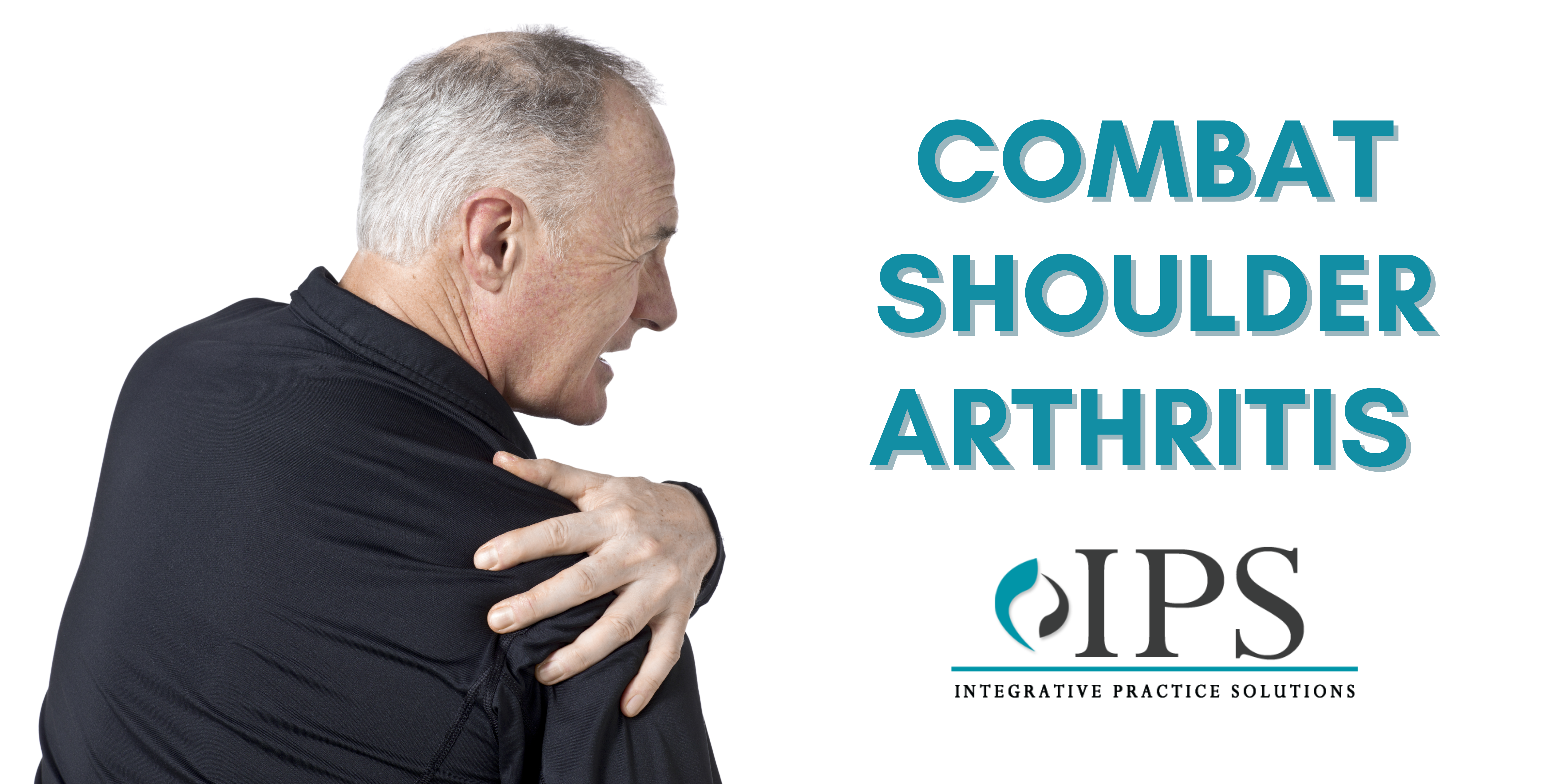Osteoarthritis is primarily caused by age related wear and tear of the joint involving the articular surface. As the cartilage is degraded, there is less protection for the bones and ultimately there is bone on bone contact. This results in the pain felt around the joint.
The shoulder joint is comprised of three bones, the scapula, the humerus and the clavicle. The shoulder is a ball and socket joint. The head of the humerus has a ball like structure that fits into the shallow socket in the scapula.
The surfaces are covered with articular cartilage that allows smooth friction free movement. A thin smooth tissue called the synovial membrane makes a small amount of fluid that lubricates the cartilage and eliminates the friction. This fluid contains hyaluronic acid.
Muscles and tendons surround the joint and provide stability and support through the range of motion.
Due to the natural wear and tear that can take place in the shoulder joint over time, osteoarthritis commonly affects people over the age of 50. Overall, osteoarthritis of the shoulder joint affects 30 percent of the population over the age of 60 and the incidence continues to increase in each subsequent decade of life.
Shoulder joints are less susceptible to wear and tear than other joints such as hips and knees but increases in sports participation has contributed to rising numbers in the younger than 50 population.
Shoulder Arthritis Risk Factors
Advancing age with loss of cartilage making the joint overall less flexible and the joint space thinner
Trauma to the joint such as broken bones or dislocation
Genetics, hereditary factors determine the overall strength and durability of cartilage as well as the attachment to the bone
Congenital defect or illness can increase risk. Gout, septic arthritis and congenital disorders can affect alignment of bones causing an increase of stress on the joint and can lead to dislocations and bony abnormalities
What is the Overall Cause of Osteoarthritis of the Shoulder?
Gender- Shoulder osteoarthritis is more common in women than men
Athletics- Certain sports use repetitive motions of the shoulder and others place huge stress on the joint. Often injured joints can develop early onset post traumatic arthritis. This is a type of arthritis not caused by age by overall repetitive trauma or microtrauma to the joint.
Symptoms of Arthritis of the Shoulder
A. Pain with or without activity
B. Stiffness
C. Loss of range of motion
D. Swelling
E. Tenderness
F. Grinding sensation on motion
Diagnosis
History and Physical- access the range of motion, muscle strength and tenderness. History of family genetic abnormalities and personal history of work, sports participation, trauma, and any other contributing medical problems
X Rays to evaluate joint space for narrowing, bone spurs and other damage
MRI is commonly ordered to evaluate the rotator cuff and the overall joint space itself ie tears in the labrum
Joint fluid may be aspirated for lab analysis
Blood testing for metabolic causes of the arthritic process, gout, rheumatoid arthritis, infection etc.
Treatment
Treatment is usually classified into nonsurgical and invasive surgical treatment.
Non-Surgical
A. Activity Modification
B. Rest
C. Cold to area
D. Physical therapy
E. Anti-inflammatory medications such as aspirin, Tylenol, NSAIDS, (ibuprofen)
F. Steroid injections
G. Multiple others
H. Hyaluronic Acid
I. Platelet Rich Plasma
J. Regenerative therapy
Surgical
A. Arthroscopic- small incision and a camera and instruments are inserted to attempt to repair the defects in the shoulder joint
B. Osteotomy- realigning the bones to their normal anatomic position by resecting the bones
C. Joint fusion- removing the cartilage and fusing the bones on either side of the joint
D. Joint reconstruction/full or partial shoulder replacement- removing parts of the bones and creating an artificial joint with metal or plastic implant
Shoulder replacement surgery has a complication rate of 3-8% and include infection, fracture, nerve damage, instability, loosening of the prosthesis, continued pain and weakness, rotator cuff tearing and revision surgery.
Hyaluronic acid was approved for use in the shoulder in the early 2000’s. It has been provided extensively throughout the world for use in the knees, ankles, hips and shoulders with thousands of doses given.
Hyaluronan is a naturally occurring polymer found in high concentrations in joints. It acts as a lubricant and shock absorber.
Hyaluronans have been used for the treatment of pain and inflammation associated with degenerative disorders especially the knee. It has been found that in osteoarthritic joints at least 50% of the hyaluronic acid normally present has been lost. Numerous clinical trials have evaluated the efficacy and safety of hyaluronic acid supplementation in patients with osteoarthritis.
The postulated mechanism of action of HA includes action on pain receptors and action on inflammatory cells. It forms a viscous coating over the synovial and cartilage lining. As a barrier HA inhibits the function of phagocytosis and adherence of inflammatory leukocytes. Intra-articular administration reduces inflammatory mediators including cyclic AMP and prostaglandin.
Hyaluronic acid forms a mesh like network in the synovial fluid allowing passage of small molecules such as nutrients but blocking the passage of larger inflammatory proteins.
HA modulates pain perception directly through inhibition of nociceptors and through binding of substance P which is involved in the transmission of pain signals.
Human and animal studies both suggest that HA has a chondroprotective effect delaying the progression of osteoarthritis.
HA does not have the detrimental effect on the rotator cuff when compared to steroids. In many studies both HA and steroids were effective. However, hyaluronic acid had a much longer benefit. There was no difference with respect to post treatment pain relief, increased range of motion or surgical requirements. However, those who went to surgery, biopsies were taken from the rotator cuff stumps and when compared those who had been injected with HA pre-operatively, the collagen fibers in the tendons were significantly denser than those treated with steroids. Also, those treated with HA had better post-operative outcomes.
Repeated steroid injections caused severe local destruction, softer residual cuff and poor surgical results.
Studies
NASHA Hyaluronic Acid for the Treatment of Shoulder Osteoarthritis: A Prospective single -arm Clinical Trial
Med Devices 2019; 12:227-234 PMID 31354368 https://journals.sagepub.com/doi/10.1177/0363546508326984
Background: Osteoarthritis of the shoulder or glenohumeral joint is a painful condition that can be debilitating. Intra-articular injection with hyaluronic acid should be considered for patients not responding adequately to physical therapy or anti-inflammatory medication.
Conclusion: This study provides preliminary evidence that a single shot of NASHA (non-animal hyaluronic acid) may be efficacious in patients with symptomatic OA. Improvements in pain were clinically and statistically significant and sustained over the 6 month follow up period.
Hylan G-F 20 Versus Triamcinolone in the Treatment of Primary Shoulder Osteoarthritis, Randomized Trial
Acta Ortop 2022 Jan 28; 30(1): e244410 PMID 35431636 https://www.ncbi.nlm.nih.gov/pmc/articles/PMC8979357/
Introduction: The aim of this study was to evaluate the effect of using intra-articular injection of HA on primary osteoarthritis compared with an intra-articular triamcinolone
Conclusion: Both injections led to a decrease in pain and an increase in patient satisfaction. The results tend to be better and longer lasting in patients receiving hyaluronic acid.
Optimal Management of Glenohumeral Osteoarthritis
Ortho Res Rev 2018;10:9-18 PMID 30774456 https://pubmed.ncbi.nlm.nih.gov/30774456/
Introduction: Glenohumeral osteoarthritis is defined as a progressive loss of articular cartilage resulting in bony erosion, pain and decreased function. This article provides a gross overview of this disease, along with peer reviewed research by experts in the field.
In the review- Comparison of methylprednisolone to hyaluronic acid, both groups had significant improvement in pain at one month. Only the hyaluronic acid had sustained pain relief at 6 months.
In 2022, Medicare covered hyaluronic acid injections into the shoulder joint in 10 states.
Illinois, Minnesota, Wisconsin, Connecticut, New York, Maine, Massachusetts, New Hampshire, Rhode Island and Vermont
There have recently been changes as to the coverage and viscosupplementation of the shoulder is now Medicare approved for the original hyaluronic products.
Integrative Practice Solutions has been instructing medical personnel and their administrative staff on the use and coding of viscosupplementation. IPS has over a decade of experience in this field and has collaborated in establishing over 200 facilities in the US. IPS has patented the AARP protocol for use in the patients with osteoarthritis of the knee. The results have far surpassed normal reported outcomes. Today, IPS is aiding the professional in the use of viscosupplementation for the treatment of shoulder osteoarthritis.
Integrative Practice Solutions and its sister corporation, Juventix Regenerative Medical are industry leaders in their respective scope of medicine and will continue to provide innovative non-surgical solutions to common medical problems.
Restore, Revive, Regenerate
Regenerative Regards,
Dr. Robert McGrath



